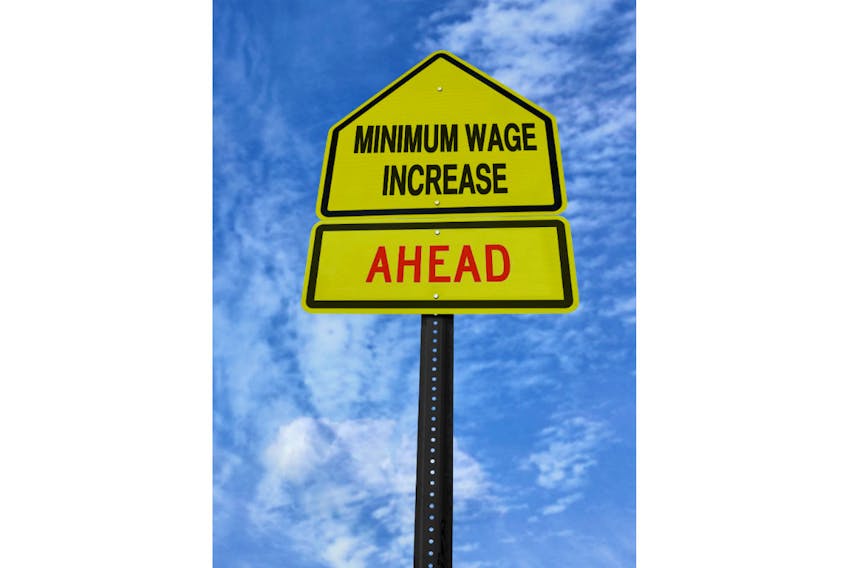By Janis Byrne
Minimum wage is a hot topic across North America.
There is a burgeoning movement across the United States and Canada to move to a $15-an-hour minimum wage. For Newfoundland and Labrador, I’d like to see us slow down and get things right.
Presently, our province is going through a minimum wage review with a panel of dedicated volunteers pressured with tight time constraints. Government should not be in a rush to push this initiative through, especially when there are so many potential impacts to consider.
Let’s take a look at who makes minimum wage.
Of the 205,900 workers in the province in 2018, about 13,200 earned the minimum wage, representing about 6.4 per cent of the labour force. Approximately 7,200 of these workers were youth between age 15 and 24, who are living at home. They are summer students, part-timers, people who work in restaurants or retail, who are also compensated by tips or commission.
Minimum wage is more than a minimum — it is a benchmark.
Employees making above the minimum wage want to maintain the separation of wages (and purchasing power) they have, as their jobs likely require special skills or training that attract wages above the minimum wage.
A sudden and significant increase in minimum wage puts Inflationary pressure not only on wages, but also on the cost of all goods and services, thereby reducing the purchasing power of those with the lowest incomes (those whom the minimum wage increase is trying to help), as well as those making above the current minimum wage.
Dr. Sara Lemos, an economics professor from the University of Leicester who specializes in labour market economics, wages, and employment, reviewed 20 studies on minimum wage increases and found that a 10 per cent increase in the minimum wage led to food prices rising by up to four per cent. One can anticipate that a 32 per cent increase in the minimum wage (raising it to $15 an hour from the current $11.40) will cause food prices to rise even higher.
Inflation in food prices effectively makes it harder for those who the increase is trying to help, especially since Newfoundland and Labrador already has the highest food costs of any province in Canada, according to a 2017 Statistics Canada study.
The food service industry will be one of the hardest hit if there is a sudden increase to the minimum wage. The average pre-tax profit margin for restaurants and other foodservice businesses in Newfoundland and Labrador is only 4.1 per cent. According to the Canadian Restaurant Association, N.L. has the highest labour cost as a share of revenue in the country at 34.7 per cent ( the Canadian average is only 31 per cent).
Many restaurants in N.L. are small businesses, and their success is vital to the communities where they operate. A study out of the U.S. by Harri, a restaurant workplace management platform, found that to pay for the imposed minimum wage pay hikes, restaurants raised menu prices, cut worker hours, cut jobs, or in some instances owners even had to close their restaurants.
Retail trade is also adversely impacted. This industry operates with unpredictable workforce requirements and a high number of seasonal or temporary workers, resulting in fluctuating variable costs. With the immediate injection of a higher minimum wage, this may make it difficult to maintain profitability. Due to the competitive nature of the retail market, many small and medium-sized businesses operating on thin profit margins will begin to consider market exits if larger competitors dominate the industry.
Can the larger retail box stores absorb a sharp and immediate increase in the minimum wage? Perhaps.
However our smaller, local businesses will undoubtedly have to raise prices and consider layoffs should there be a sudden and dramatic increase.
For people on fixed income supplements who are not in the labour force, this issue becomes even worse. In 2018, the Newfoundland and Labrador Statistics Agency reported that 39,665 individuals in Newfoundland and Labrador received income support. This represents 7.7 per cent of the population, a higher percentage than those who make the minimum wage. As income support payment amounts are not indexed to the cost of living, the purchasing power of these individuals decreases when inflationary prices come into effect. People from all walks of life are impacted, notably seniors, single parents, and persons with disabilities relying on these income supplements.
The solution to eliminating poverty and assisting minimum wage earners is multi-faceted and a $15 minimum wage is not the silver bullet. The Ontario government struck a panel in 2013 to investigate the minimum wage’s economic impacts and found that the “link between poverty and low wages is weak.” The panel also noted that “some studies even find that a higher minimum wage leads to an increase in poverty.” The panel noted a study where a 10 per cent increase in the minimum wage was linked with a 4-6 per cent increase in Canadian families living in relative poverty over a 20-year span.
The panel explained that “higher minimum wages trigger higher unemployment, which results in more poverty as household incomes drop among low-income families.”
While an increase in the minimum wage is not a silver bullet, it can certainly be viewed as a blunt instrument of public policy, which can have unintended consequences.
The formula which government set two years ago is working. Minimum wage is reviewed annually and is adjusted based upon the Consumer Price Index. This formula provides business certainty and removes minimum wage from the political process. Employers have consistently demonstrated a commitment to paying a fair wage. Average weekly earnings in Newfoundland and Labrador are the second highest in the country and have steadily climbed since 2001. Statistics Canada reports that in Newfoundland and Labrador we saw 2018 hourly employees average weekly earnings at $785.78, equivalent to $19.64 per hour for a 40-hour week. This shows that employers, of their own volition, want to pay employees as much as they can. It translates to higher employee retention, increased productivity, and a successful business. However, the inflationary impacts of a sudden hike to $15 or even $13 an hour may well have devastating effects on the small local businesses with the low profit margins, who will then be forced to raise prices and lay off workers.
Let’s not rush to an increased minimum wage without fully analyzing the societal benefits and detriments. Fighting poverty is a complex problem, and as noted above it is very important that the unintended consequences of a sharp and immediate increase in the minimum wage be examined.
This is bigger than politics. We have the opportunity to make an informed and educated decision.
Let’s do that.
Janis Byrne is chair of the St. John’s Board of Trade.
RELATED:
- Businesses need time to adjust to minimum-wage hikes: CFIB
- LETTER: Raising the minimum wage is the right thing to do









